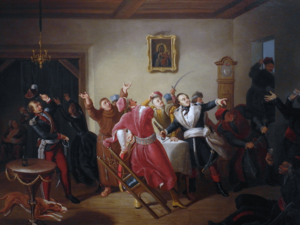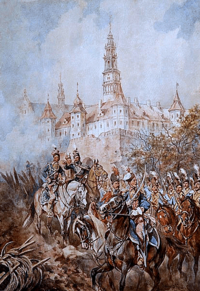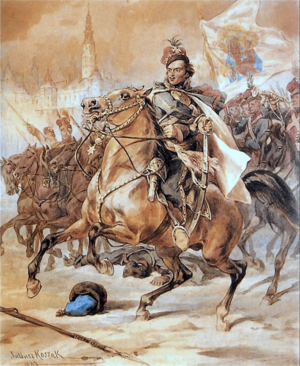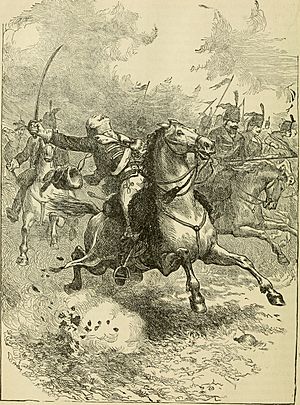Casimir Pulaski facts for kids
Quick facts for kids
Casimir Pulaski
|
|
|---|---|
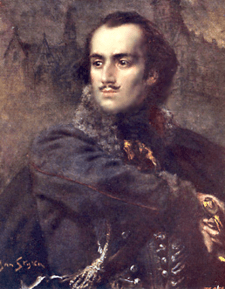
|
|
| Native name |
Kazimierz Pułaski
|
| Born | March 4, 1745 or March 6, 1745 Warsaw, Polish–Lithuanian Commonwealth |
| Died | October 11, 1779 (aged 34) Thunderbolt, Georgia, U.S. |
| Buried |
Monterey Square, Savannah, Georgia, U.S.
|
| Allegiance |
|
| Service/ |
|
| Years of service | 1762–1779 |
| Rank | Brigadier general |
| Unit | Pulaski's Legion |
| Battles/wars | |
| Signature | |
Kazimierz Pułaski (born March 4 or 6, 1745 – died October 11, 1779) was a Polish nobleman and military leader. He is often called the "father of the American cavalry" because of his important role in the American Revolutionary War.
Born in Warsaw, Poland, Pułaski became interested in politics and military life early on. He joined the Bar Confederation, a group fighting against foreign control of the Polish–Lithuanian Commonwealth. When this fight failed, he had to leave his home country.
Later, Benjamin Franklin suggested that Pułaski go to North America. There, he joined the fight for American independence. He became a general in the Continental Army. He was especially known for saving George Washington's life during a battle.
Pułaski and his friend, Michael Kovats, created a special cavalry unit called the Pulaski Cavalry Legion. They helped improve the American cavalry. Pułaski was badly wounded during the Siege of Savannah while leading a cavalry charge. He died shortly after.
Today, Pułaski is remembered as a hero who fought for freedom in both Poland and the United States. Many places and events are named after him. He is also one of only eight people to be given honorary United States citizenship.
Contents
Early Life
Kazimierz Pułaski was born on March 6, 1745, in Warsaw, Poland. His family, the Pułaskis, were Roman Catholic and used the Ślepowron coat of arms. His father, Józef Pułaski, was an important person in their town.
Kazimierz had two brothers, Franciszek Ksawery Pułaski and Antoni Pułaski. As a young boy, he went to an elite school in Warsaw. However, he did not finish his education there.
Military Adventures
In 1762, Pułaski began his military career. He worked as a page (a young assistant) for the Duke of Courland, who was connected to the Polish king. After six months, he returned to Warsaw. His father gave him a village, and Pułaski took on the title of Starost (a type of local official) of Zezulińce.
Fighting for Poland's Freedom
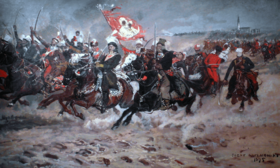
In 1764, Pułaski and his family took part in choosing a new Polish king. By December 1767, Pułaski and his father joined the Bar Confederation. This group believed the new king, Stanisław II Augustus, was controlled by Russia. They wanted to stop Russia from having too much power over Poland.
Pułaski quickly became a leader. He gathered his own military unit. On February 29, 1768, he officially joined the Confederation. Soon after, he was made a pułkownik (colonel) and led a cavalry unit.
He fought his first battle on April 20, 1768, near Pohorełe, and won. He had another victory on April 23. However, he faced a defeat on April 28. In May, he defended a monastery in Berdyczów for over two weeks. He was eventually captured by the Russians.
Pułaski was released after promising not to fight the Confederates again. But he didn't keep this promise. He publicly said he would continue to fight for freedom. This made some people doubt him, but he was soon back in action.
In 1769, Pułaski's unit was surrounded again. This time it was at the old fortress of Okopy Świętej Trójcy. He bravely defended it and broke the Russian siege. He was then made a regimentarz (a military commander) for the Kraków region.
He tried to start a bigger uprising in Lithuania. Even though he didn't win any major battles there, he managed to gather a 4,000-strong army. This made him known as a very effective military leader in the Bar Confederation.
One of his most famous actions was helping to defend the Jasna Góra monastery from September 1770 to January 1771. He and other commanders successfully protected it against Russian forces. This defense made him even more famous in Poland and other countries.
In 1771, Pułaski became part of the Confederates' War Council. A French military adviser, Charles François Dumouriez, described him as "brave and honest." However, Pułaski sometimes refused to follow orders. He loved fighting the Russians and was very daring in battle.
Later in 1771, Pułaski was involved in a plan to capture King Poniatowski. He was against harming the king, but the plan failed. This event hurt the reputation of the Confederates. When Pułaski's part in the plan became known, he was forced to leave Austrian lands.
By 1772, the Bar Confederation was defeated. Pułaski left Poland and went to Prussia. He was seen as one of the most important leaders of the Confederation. However, he often acted on his own, which sometimes caused problems.
After leaving Prussia, Pułaski tried to join the French Army but couldn't. In Poland, he was accused of trying to harm the king. A court found him guilty while he was away, and he was sentenced to death. King Poniatowski himself warned Pułaski not to return to Poland.
Pułaski tried to start a new force in the Ottoman Empire, but it didn't work out. He was in debt and couldn't find an army to join. He spent 1775 in France, even being put in prison for his debts. Finally, his friends helped him get released.
Around this time, Benjamin Franklin and the Marquis de Lafayette recruited him. They wanted him to help in the American Revolutionary War.
Fighting for America's Freedom
Franklin was very impressed by Pułaski. He wrote to General George Washington, saying Pułaski was "famous throughout Europe for his bravery" and could be very useful to the American cause. Pułaski left France in June 1777 and arrived in America on July 23, 1777. He wrote to Washington, "I came here, where freedom is being defended, to serve it, and to live or die for it."
On August 20, he met Washington near Philadelphia. Pułaski showed off his riding skills and explained why cavalry (soldiers on horseback) were so important. Washington couldn't give him an officer rank right away, so Pułaski waited.
His first battle in America was on September 11, 1777, at the Battle of Brandywine. When the American troops started to fall back, Pułaski quickly rode to Washington. He reported that the British were trying to cut off their escape route. Washington told him to gather scattered troops and help the army retreat. Pułaski's quick actions saved the American cavalry from a big defeat and even saved Washington's life.
Because of his bravery, Congress made Pułaski a brigadier general in the Continental Army cavalry on September 15, 1777. At that time, the American cavalry was small. Pułaski immediately started to reorganize it and wrote the first rules for how it should operate.
Pułaski also took part in the Battle of Germantown on October 4. He spent the winter of 1777-1778 with the army at Valley Forge. He wanted to keep fighting through the winter, but his idea was not accepted. Instead, he focused on training the cavalry.
American officers sometimes found it hard to work with Pułaski. He spoke little English, and his ideas about discipline and tactics were different. There were also problems with pay for his unit. Despite these challenges, Pułaski was dedicated.
In March 1778, Pułaski resigned his general command. He then suggested creating a new unit. Congress approved his idea, and he formed a special corps called the Pulaski Cavalry Legion. This unit had lancers (soldiers with long spears) and light infantry. It was based in Baltimore and had about 330 men, both Americans and foreigners.
Pułaski was a strict leader and trained his men well. He even used his own money to make sure his troops had the best equipment. He was known as the "father of the American cavalry."
In the autumn, Pułaski's Legion suffered heavy losses in a fight called the Affair at Little Egg Harbor in New Jersey. He was later ordered to the Southern front. On February 2, 1779, Washington sent him to South Carolina.
Southern Battles
Pułaski arrived in Charleston on May 8, 1779. The city was in danger. The British had captured Savannah and were now moving towards Charleston. Pułaski's Legion fought the British on May 11. His infantry unit was almost completely destroyed, and he had to retreat.
Even though he often got sick with malaria in Charleston, Pułaski kept fighting. In September, the Americans, with help from the French, planned to take back Savannah. Pułaski's units were the advance guard for the French forces. He helped greatly during the siege of Savannah. On October 9, he led all the cavalry, both French and American, in an attack.
Death and Legacy
During a cavalry charge, Pułaski was badly wounded by grapeshot (a type of cannon ammunition). He was carried off the battlefield and taken to a ship, the Wasp. He died two days later, on October 11, 1779, without waking up. His brave death made him an even bigger hero in America.
Pułaski never married and had no children. There has been some debate about where he was buried. Many historical records say he was buried at sea. However, some witnesses claimed he was taken to Greenwich Plantation near Savannah, where he died and was buried.
In March 1825, the Marquis de Lafayette laid the first stone for the Casimir Pulaski Monument in Savannah, Georgia.
Honoring a Hero
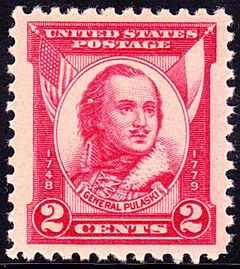
The United States has honored Pułaski for a long time. In 1779, Congress said a monument should be built for him. The first one, the Casimir Pulaski Monument in Savannah, was finished in 1854. A statue of him was added to the United States Capitol in 1867. In 1910, US President William Taft unveiled another statue of General Casimir Pulaski.
Since 1929, October 11 is celebrated as "General Pulaski Memorial Day" in the US. A big parade is held every year in New York City. In Illinois, "Casimir Pulaski Day" is celebrated on the first Monday of March, and it's a school holiday in some areas.
In 2009, Congress made Pułaski an honorary U.S. citizen. President Barack Obama signed this into law on November 6, 2009. This made Pułaski the seventh person to receive this honor.

In Poland, Pułaski's sentence from 1773 was officially canceled in 1793. Many Polish writers have mentioned him in their works. A museum dedicated to him, the Casimir Pulaski Museum, opened in Warka, Poland, in 1967.
People in both Poland and the United States celebrate his birth and death anniversaries. There are many paintings and statues of him. Songs and operas have been written about him. Commemorative medals and stamps have also been issued.
Many places in the United States are named after him. These include cities, towns, counties, streets, parks, and buildings.
- The Pulaski Bridge in New York City connects Brooklyn to Queens.
- The Pulaski Skyway in New Jersey links Jersey City to Newark.
- The Pulaski Highway goes through Baltimore, Maryland.
- Fort Pulaski National Monument in Georgia is named in his honor.
- Pulaski Barracks, a US Army post in Germany, is also named for him.
Several schools and Polish-American groups are named after him. A US Navy submarine, USS Casimir Pulaski, and a Polish frigate, ORP Generał Kazimierz Pułaski, have also been named after him.
Historians see Pułaski as one of Poland's most important military heroes. He is often compared to other great Polish commanders like Tadeusz Kościuszko.
Images for kids
-
Map of the Bar Confederation conflict in Poland between 1768 and 1772, with white areas being controlled by the Confederates
See also
 In Spanish: Kazimierz Pułaski para niños
In Spanish: Kazimierz Pułaski para niños
- Johann de Kalb, a Bavarian-born French officer who served as a general in the Continental Army
- Gilbert du Motier, Marquis de Lafayette, a French officer who served as a general in the Continental Army
- Michael Kovats de Fabriczy, a Hungarian nobleman and cavalry officer who served in the Continental Army
- Friedrich Wilhelm von Steuben, a Prussian drill master who served in the Continental Army



